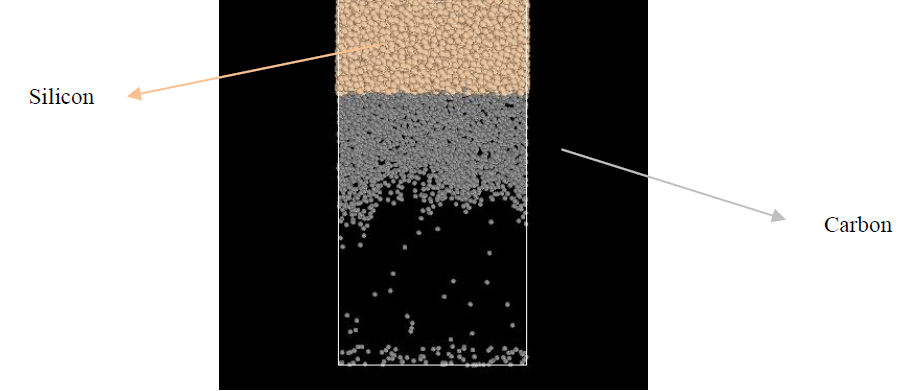Thermal Evaporation of Graphene on Silicon: A Molecular Dynamics Simulation
DOI:
https://doi.org/10.55981/jsmi.2025.7953Keywords:
Graphite, Silicon, Thermal evaporation, Molecular dynamics, SimulationAbstract
Silicon, a ubiquitous element in modern electronics, underpins the operation of countless devices due to its unique semiconducting properties. However, as device dimensions shrink to the nanoscale, silicon-based devices face limitations such as increased power consumption and decreased performance. Coating silicon with graphene is aimed to improve the device performance and extend the limits of silicon’s performance. Conducting experimental work involving graphene for thin coatings is a resource-intensive process. Hence, molecular dynamics (MD) simulation is necessary to illuminate the evaporation and coating mechanisms at the atomic scale, serving as a valuable tool for experimental design. These molecular dynamics simulations have elucidated the intricate relationship between temperature and deposition time in governing the quantity and spatial distribution of carbon atoms on a silicon substrate. Within a 300 ps deposition interval, a non-linear correlation between temperature and carbon deposition is observed, indicating that the allotted time is insufficient for complete atomic diffusion and homogeneous distribution. At elevated temperatures, carbon atoms accumulate, impeding the diffusion of subsequent atoms. Conversely, a 600 ps deposition period reveals a direct proportionality between temperature and carbon deposition, attributed to the enhanced mobility of carbon atoms, facilitating their dispersion and creation of vacancies within the substrate.
Downloads
References
[1] N. Marsi, B. Yeop Majlis, F. Mohd-Yasin, H. Erny Zainal Abidin, and A. Azlan Hamzah. "A review: Properties of silicon carbide materials in MEMS application." International Journal of Nanoelectronics and Materials, vol. 13, p. 113, 2020.
[2] S. A. Kukushkin and A. V. Osipov. "Theory and practice of SiC growth on Si and its applications to wide-gap semiconductor films." Journal of Physics D: Applied Physics, vol. 47, no. 31, p. 313001, 2014.
https://doi.org/10.1088/0022-3727/47/31/313001
[3] A. P. Prskalo, S. Schmauder, C. Ziebert, J. Ye, and S. Ulrich. "Molecular dynamics simulations of the sputtering of SiC and Si3N4." Surf. Coat. Technol., vol. 204, no. 12-13, pp. 2081-2084, 2010.
https://doi.org/10.1016/j.surfcoat.2009.09.043
[4] Y. Zhang, H. Shu, Z. Chen, G. Mu, Y. Sui, Y. Liang, S. Hu, J. Li, H. Kang, and G. Yu. "Chemical vapor deposition growth and characterization of graphite-like film." Mater. Res. Express, vol. 7, no. 1, 2020.
https://doi.org/10.1088/2053-1591/ab664b
[5] S. Xu, L. Zhang, B. Wang, and R. S. Ruoff. "Chemical vapor deposition of graphene on thin-metal films." Cell Reports Physical Science, vol. 2, no. 3, p. 100372, 2021.
https://doi.org/10.1016/j.xcrp.2021.100372
[6] S. Nishino, H. Suhara, H. Ono, and H. Matsunami. "Epitaxial growth and electric characteristics of cubic SiC on silicon." J. Appl. Phys., vol. 61, no. 10, pp. 4889-4893, 1987.
https://doi.org/10.1063/1.338355
[7] S. C. Kim, W. Huang, Z. Zhang, J. Wang, Y. Kim, Y. K. Jeong, S. T. Oyakhire, Y. Yang, and Y. Cui. "Graphene coating on silicon anodes enabled by thermal surface modification for high-energy lithium-ion batteries." MRS Bull, vol. 47, no. 2, pp. 127-133, 2022.
https://doi.org/10.1557/s43577-021-00191-4
[8] S. Plimpton. "Fast Parallel Algorithms for Short-Range Molecular Dynamics." J. Comput. Phys., vol. 117, no. 1, pp. 1-19, 1995.
https://doi.org/10.1006/jcph.1995.1039
[9] A. Stukowski. "Visualization and analysis of atomistic simulation data with OVITO-the Open Visualization Tool." Model. Simul. Mat. Sci. Eng., vol. 18, no. 1, p. 15012, 2009.
https://doi.org/10.1088/0965-0393/18/1/015012
[10] J. Tersoff. "New empirical approach for the structure and energy of covalent systems." Phys. Rev. B, vol. 37, no. 12, pp. 6991-7000, 1988.
https://doi.org/10.1103/PhysRevB.37.6991
[11] J. Tersoff. "Chemical order in amorphous silicon carbide." Phys. Rev. B, vol. 49, no. 23, pp. 16349-16352, 1994.
https://doi.org/10.1103/PhysRevB.49.16349
[12] O. Knotek, F. Löffler, and L. Wolkers. "Amorphous SiC PVD coatings." Diam. Relat. Mater., vol. 2, no. 2-4, pp. 528-530, 1993.

Downloads
Published
How to Cite
Issue
Section
License
Copyright (c) 2025 mauludi ariesto pamungkas, A. B. Gien, F. S. Farista, D. J. D. H. Santjojo

This work is licensed under a Creative Commons Attribution-ShareAlike 4.0 International License.







